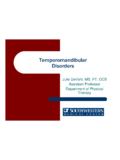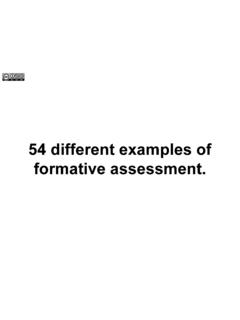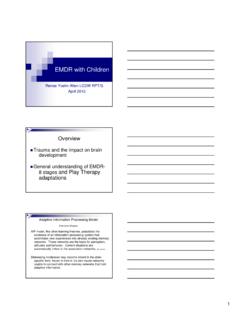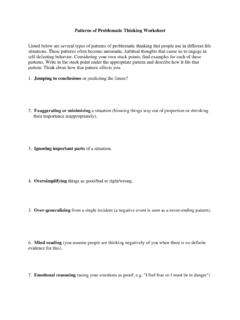Transcription of SELF-ADVOCACY AND PERSONAL FUTURES …
1 SELF-ADVOCACY AND PERSONAL FUTURES PLANNING Transition planning involves thinking about goals after high school and developing a long-range plan to get there. This includes having a high school experience that focuses on developing the skills and competencies needed to achieve life goals. It also involves helping the student identify and link with any post-school adult service programs or supports they may need. There are a variety of person-centered planning tools that can help students develop life and career goals. Tools such as MAPS, Essential Lifestyle Planning, PERSONAL FUTURES Planning, PATH, and Circles of Support can assist students with identifying the supports and services that can help them reach PERSONAL goals.
2 Person-centered planning uses a facilitator to bring together the student and a group of people who know the student best. This group can include family members, friends, neighbors, school personnel, etc. Common themes to all person-centered planning activities include acknowledging the student and family s dreams for the future , identifying obstacles to fulfilling those dreams, and identifying PERSONAL strengths and community resources. The planning process should support the student in developing his/her SELF-ADVOCACY skills. SELF-ADVOCACY means speaking up for oneself. It requires knowledge of PERSONAL strengths and needs and rights as a citizen, and involves acting in an assertive manner to make needs known to others.
3 SELF-ADVOCACY includes the following components: 1. Disability Awareness 2. Learning to Advocate 3. Career Planning and Community Connections 4. Participating in PPT Meetings These components, and a brief overview of the skills necessary to achieve positive SELF-ADVOCACY outcomes, follow: Connecticut State Department of Education/Bureau of Special Education Transition Task Force/Transition Training Manual Disability Awareness Whether a student s plans after high school involve work or college, it is important that he/she understand his/her strengths and limitations, know how they affect performance, and be able to communicate this to others. Understanding one s disability is the first step in the process.
4 In order to help students develop greater self -awareness, they should: begin to accept their disability as a description of how they learn or function in a particular environment; know what accommodations work for them; and understand that their disability designation gives them certain rights to services and protection from discrimination under the Americans with Disabilities Act (ADA) and Section 504 of the Rehabilitation Act. Learning to self -Advocate State and federal laws such as the Americans with Disabilities Act (ADA) and Section 504 of the Rehabilitation Act were passed to give students and adults with disabilities an equal opportunity to education and employment.
5 These laws allow them to access the same facilities and programs available to individuals without disabilities. The ADA and Section 504 of the Rehabilitation Act also give individuals with disabilities the right to request specialized services, devices, or instructional modifications to help them work and learn. It is an individual s responsibility to take advantage of these laws by becoming a self -advocate. In order to effectively self -advocate, a student should be able to: describe their accommodation needs in terms of making things equal, rather than asking for an unfair advantage; develop an assertive style of communication; identify barriers to effective communication and include specific SELF-ADVOCACY objectives in their IEP; and Know when they should and should not disclose their disability.
6 Connecticut State Department of Education/Bureau of Special Education Transition Task Force/Transition Training Manual An example of a PERSONAL SELF-ADVOCACY olan is included here. Students should complete this plan prior to participating in their annual PPT meeting. Connecticut State Department of Education/Bureau of Special Education Transition Task Force/Transition Training Manual My PERSONAL self advocacy Plan Name: _____ Grade: _____ Date: _____ My disability is: _____ My learning strengths are: _____ _____ _____ My learning weaknesses are: _____ _____ _____ I learn best when: _____ _____ _____ The specific classroom modifications I need are: _____ _____ _____ I need to develop the following SELF-ADVOCACY skills.
7 _____ _____ _____ Connecticut State Department of Education/Bureau of Special Education Transition Task Force/Transition Training Manual Career Planning/Community Connections A broad network of family and friends is important to help students develop and reach their goals. Friends and family members can help make decisions, assist in obtaining needed services, and identify others who can help with the career-planning process. The wider the network, the better. In order for students to make a successful transition they need to: develop a support network; develop mentoring relationships; seek out information on person-centered planning tools that can help in planning for the future ; take career interest inventories; have a variety of real, community-based work experiences; and identify adult service provider and advocacy agencies.
8 Participating in PPT Meetings Developing the ability to effectively self -advocate involves not only learning new skills, but also seeking out environments to practice SELF-ADVOCACY skills. The annual Planning and Placement Team (PPT) meeting is one of the best opportunities students have to develop their SELF-ADVOCACY skills. It is important that students attend these meetings and become active participants in the planning process. There are a number of things students can do to increase their ability to speak up for themselves at PPT meetings. Understand their rights and responsibilities as a member of the Planning and Placement Team (PPT). Attend each and every meeting held to discuss and plan their Individualized Education Program (IEP).
9 Practice talking about their goals, strengths, weaknesses, and accommodation needs. Take an active role in leading or facilitating the PPT. The following PPT self -Determination Checklist and the PPT self -Determination Worksheet can help students better prepare for their Planning and Placement Team meetings. Connecticut State Department of Education/Bureau of Special Education Transition Task Force/Transition Training Manual PPT self -Determination Checklist Place a check mark next to each activity you will assume responsibility for: I will attend my next PPT meeting I will participate in the following ways: Introduce myself State the purpose of the meeting Introduce the other PPT members (or)
10 Ask the other PPT members to introduce themselves Ask someone to take notes for my IEP Ask PPT members to report on my academic progress and related services Describe my disability, strengths and weaknesses, and how I think I did in school this year State my transition goals in the areas of employment/postsecondary education, independent living, and community participation Describe my educational program for the coming school year, including goals and objectives, classroom modifications State my concerns/needs and ask PPT members for input Thank everyone for coming I will not attend my next PPT meeting, but will make sure my interests, preferences, and needs are taken into consideration by the Planning and Placement Team when they develop my Individual Education Program.
















